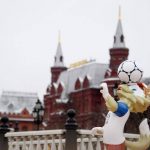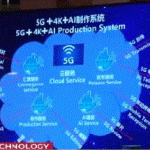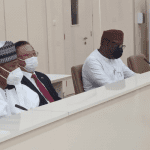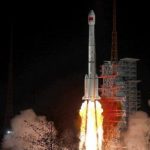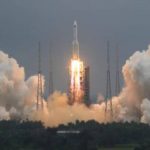The China Science and Technology Museum in Beijing has inaugurated a free exhibition on China’s crewed space program and applications.
It is the first science popularization show in the country focused on space science and applications.
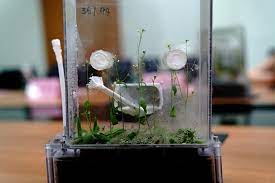
The display area is approximately 2,000 square meters, with five divisions, over ten theme scenarios, and over thirty exhibition pieces.
The original scientific experiment cabinet and Arabidopsis plants produced from seeds brought back from the space station are on display for the first time to the public.
The exhibition is sponsored by the Chinese Academy of Sciences’ Technology and Engineering Center for Space Utilization and the China Science and Technology Museum. It is free and available to the public from April 29 to June 15.
The China Science and Technology Museum in Beijing has inaugurated a free exhibition on China’s crewed space program and applications.
It is the first science popularization show in the country focused on space science and applications.

The display area is approximately 2,000 square meters, with five divisions, over ten theme scenarios, and over thirty exhibition pieces.
The original scientific experiment cabinet and Arabidopsis plants produced from seeds brought back from the space station are on display for the first time to the public.
The exhibition is sponsored by the Chinese Academy of Sciences’ Technology and Engineering Center for Space Utilization and the China Science and Technology Museum. It is free and available to the public from April 29 to June 15.
The China Science and Technology Museum in Beijing has inaugurated a free exhibition on China’s crewed space program and applications.
It is the first science popularization show in the country focused on space science and applications.

The display area is approximately 2,000 square meters, with five divisions, over ten theme scenarios, and over thirty exhibition pieces.
The original scientific experiment cabinet and Arabidopsis plants produced from seeds brought back from the space station are on display for the first time to the public.
The exhibition is sponsored by the Chinese Academy of Sciences’ Technology and Engineering Center for Space Utilization and the China Science and Technology Museum. It is free and available to the public from April 29 to June 15.
The China Science and Technology Museum in Beijing has inaugurated a free exhibition on China’s crewed space program and applications.
It is the first science popularization show in the country focused on space science and applications.

The display area is approximately 2,000 square meters, with five divisions, over ten theme scenarios, and over thirty exhibition pieces.
The original scientific experiment cabinet and Arabidopsis plants produced from seeds brought back from the space station are on display for the first time to the public.
The exhibition is sponsored by the Chinese Academy of Sciences’ Technology and Engineering Center for Space Utilization and the China Science and Technology Museum. It is free and available to the public from April 29 to June 15.
The China Science and Technology Museum in Beijing has inaugurated a free exhibition on China’s crewed space program and applications.
It is the first science popularization show in the country focused on space science and applications.

The display area is approximately 2,000 square meters, with five divisions, over ten theme scenarios, and over thirty exhibition pieces.
The original scientific experiment cabinet and Arabidopsis plants produced from seeds brought back from the space station are on display for the first time to the public.
The exhibition is sponsored by the Chinese Academy of Sciences’ Technology and Engineering Center for Space Utilization and the China Science and Technology Museum. It is free and available to the public from April 29 to June 15.
The China Science and Technology Museum in Beijing has inaugurated a free exhibition on China’s crewed space program and applications.
It is the first science popularization show in the country focused on space science and applications.

The display area is approximately 2,000 square meters, with five divisions, over ten theme scenarios, and over thirty exhibition pieces.
The original scientific experiment cabinet and Arabidopsis plants produced from seeds brought back from the space station are on display for the first time to the public.
The exhibition is sponsored by the Chinese Academy of Sciences’ Technology and Engineering Center for Space Utilization and the China Science and Technology Museum. It is free and available to the public from April 29 to June 15.
The China Science and Technology Museum in Beijing has inaugurated a free exhibition on China’s crewed space program and applications.
It is the first science popularization show in the country focused on space science and applications.

The display area is approximately 2,000 square meters, with five divisions, over ten theme scenarios, and over thirty exhibition pieces.
The original scientific experiment cabinet and Arabidopsis plants produced from seeds brought back from the space station are on display for the first time to the public.
The exhibition is sponsored by the Chinese Academy of Sciences’ Technology and Engineering Center for Space Utilization and the China Science and Technology Museum. It is free and available to the public from April 29 to June 15.
The China Science and Technology Museum in Beijing has inaugurated a free exhibition on China’s crewed space program and applications.
It is the first science popularization show in the country focused on space science and applications.

The display area is approximately 2,000 square meters, with five divisions, over ten theme scenarios, and over thirty exhibition pieces.
The original scientific experiment cabinet and Arabidopsis plants produced from seeds brought back from the space station are on display for the first time to the public.
The exhibition is sponsored by the Chinese Academy of Sciences’ Technology and Engineering Center for Space Utilization and the China Science and Technology Museum. It is free and available to the public from April 29 to June 15.



